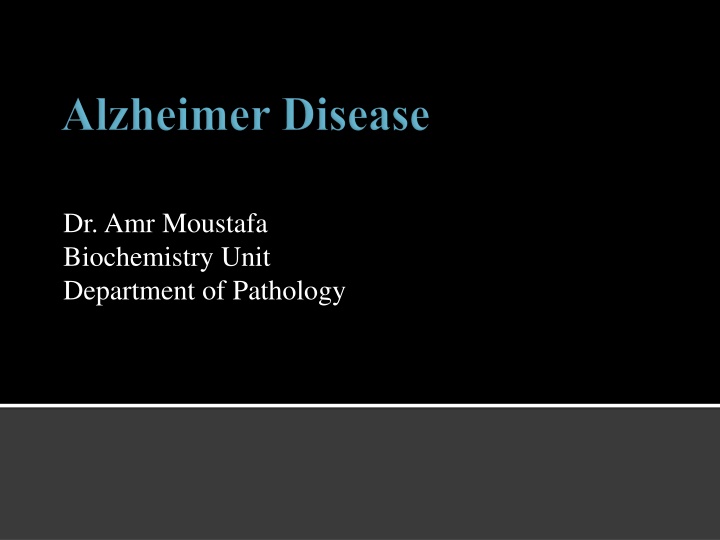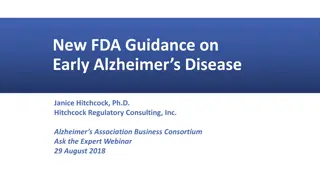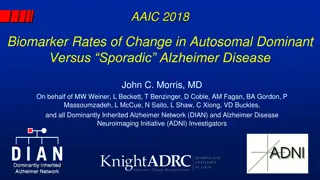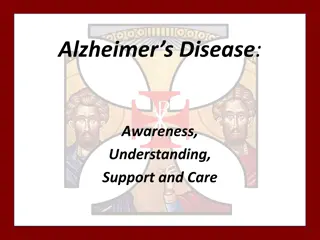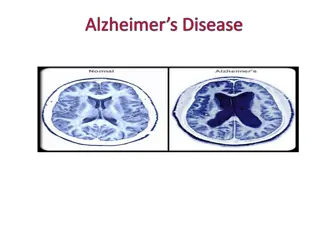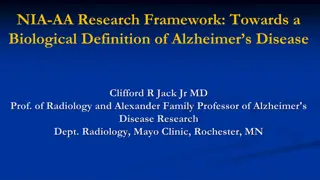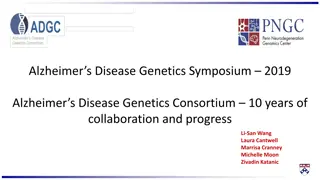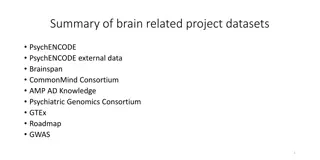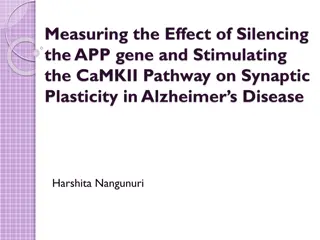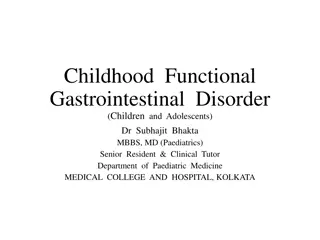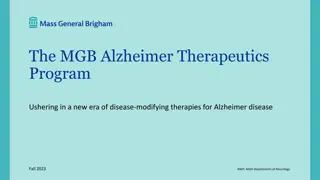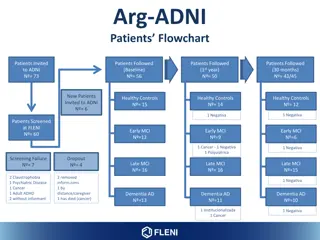Neurodegenerative Disorders and Alzheimer's Disease Overview
Diseases of gray matter involving progressive neuronal loss, protein aggregates, and cognitive decline. Learn about diagnosis, therapeutic approaches, and pathological features of Alzheimer's disease through a clinical and radiologic assessment.
Download Presentation

Please find below an Image/Link to download the presentation.
The content on the website is provided AS IS for your information and personal use only. It may not be sold, licensed, or shared on other websites without obtaining consent from the author.If you encounter any issues during the download, it is possible that the publisher has removed the file from their server.
You are allowed to download the files provided on this website for personal or commercial use, subject to the condition that they are used lawfully. All files are the property of their respective owners.
The content on the website is provided AS IS for your information and personal use only. It may not be sold, licensed, or shared on other websites without obtaining consent from the author.
E N D
Presentation Transcript
Dr. Amr Moustafa Biochemistry Unit Department of Pathology
Upon completion of this lecture, students should be able to: Have an overview of neurodegenerative disorders Understand the role of amyloid beta 40-42 residue peptide in Alzheimer s disease Get an idea of the diagnosis and therapeutic approach to treat these disorders
Diseases of gray matter characterized principally by the progressive loss of neurons The pattern of neuronal loss is selective affecting one or more groups of neurons leaving the others intact The diseases arise without any clear inciting event in patients without previous neurological deficits
A common theme is the development of protein aggregates that are resistant to normal cellular mechanisms of degradation The aggregated proteins are generally cytotoxic
A degenerative disease with the prominent involvement of the cerebral cortex Its principal clinical manifestation is dementia Dementia is the progressive loss of cognitive function independent of the state of attention Patients rarely become symptomatic before 50yrs of age, but the incidence of disease rises with age
Clinical Picture: gradual impairment of higher intellectual function alterations in mood and behavior Progressive disorientation memory loss In 5-10 yrs, the patient becomes profoundly disabled, mute and immobile Most cases are sporadic At least 5% to 10% are familial
Combination of clinical assessment and radiologic methods For definitive diagnosis, pathologic examination of brain tissue is necessary The major microscopic abnormalities of Alzheimer disease are neuritic plaques, neurofibrillary tangles, and amyloid angiopathy
Are extracellular spherical structures (20- 200um in diameter) Contain paired helical filaments as well as synaptic vesicles and abnormal mitochondria The amyloid core contains several abnormal proteins The dominant component of the plaque core is A ,a peptide derived from a larger molecule, amyloid precursor protein (APP)
The two dominant species of A, called A40 andA 42 share an N-terminus and differ in length by two amino acids. Other proteins present in the plaque in lesser abundance are Components of the compliment cascade Proinflammatory cytokines 1-antichymotrypsin apolipoproteins
Intracellular bundles of filaments in the cytoplasm of neurons that displace or encircle the nucleus A major component of filaments is abnormally hyperphosphorylated forms of the protein tau (a microtubule associated protein that enhances microtubule assembly)
Amyloid proteins build up on the walls of the arteries in the brain The condition increases the risk of hemorrhagic stroke and dementia An almost invariable accompaniment of Alzheimer disease but not specific for Alzheimer
Still being intensively studied The number of neurofibrillar tangles correlates better with the degree of dementia than does the number of neuritic plaques
The best correlation of severity of dementia appears to be with loss of synapses The A peptide forms -pleated sheets, aggregates readily and is resistant to degrdation and elicits an inflammatory response from astrocytes and microglia and can be directly neurotoxic
Are derived through the processing of APP APP is a protein of uncertain cellular function It is synthesized with a single transmembrane domain and expressed on the cell surface
-peptide (A ) TM Alpha-secretase pathway Beta-secretase pathway -stub -stub APPS APPS neurotrophic -secretase -secretase -secretase p3 A 40 A 42 neurotoxic
APP has potential cleavage sites for three distinct enzymes ( , , and -secretases) The A domain extends from the extracellular side of protein into the transmembrane domain When APP is cleaved by -secretase , subsequent cleavage by -secretase does not yield A
Cleavege by -secretase , followed by - secretase results in production of A A can then aggregate and form fibrils
Accumulation of A has several effects on neurons and neuronal function: Small aggregates of A can alter neurotransmission, and the aggregates can be toxic to neurons and synaptic endings Larger deposits, in the form of plaques, also lead to neuronal death, elicit a local inflammatory response that can result in further cell injury
Hyperphosphorylation of the microtubule binding protein tau With this increased level of phosphorylation, tau redistributes within the neuron from the axon into dendrites and cell body and aggregates into tangles This process also results in neuronal dysfunction and cell death
Mutationsin APP or in components of - secretase (presenilin-1 or presenilin-2) lead to early onset familial Alzheimer disease by increasing the rate at which A accumulates Alzheimer disease occurs in almost all patients with trisomy 21 (Down syndrome) who survive beyond 45 years (due to APP gene dosage effects) The gene encoding APP is located on chromosome 21
The search for genes associated with typical, sporadic Alzheimer disease is beginning to identify genetic associations that may provide new clues about the pathogenesis of the disease
Chromosome 21 Gene Amyloid Precursor Protein (APP) Presenilin-1 (PS1) Consequences Early onset FAD Increased A production Early onset FAD Increased A production Early onset FAD Increased A production Increased risk for development of AD Decreased age at onset of AD 14 1 Presenilin-2 (PS2) 19 Apolipoprotein E (ApoE)
Currently, no effective treatment for AD regulating neurotransmitter activity e.g., Enhancing cholinergic function improves AD studies treatment with NSAIDs decreases the risk for developing AD. Unfortunately, clinical trials of NSAIDs in AD patients have not been very fruitful. Epidemiological showed that
Proinflammatory countered through polyphenols (flavonoids). Supplementation of compounds may provide a new therapeutic line of approach to this brain disorder. responses may be these natural
Cellular therapies using stem cells offer great promise for the treatment of AD Stem cells offer 1. environmental enrichment to attenuate neurodegeneration. 2. Neurotrophic support to remaining cells or prevent the production or accumulation of toxic factors that harm neurons. Cellular replacement and/or provide
The Nobel assembly has decided to award The Nobel Prize in Physiology or Medicine, 2012 jointly to John B. Gurdon (1933) and Shinya Yamanaka (1962) for the discovery that mature cells can be reprogrammed to become induced pluripotent stem cells (iPS) www.nobelprize.org
The small aggregates of A as well as larger fibrils are directly neurotoxic They can elicit oxidative damage and alterations in calcium homeostasis But how A is related to neurodegenration of AD and how it is linked to tangles and hyperphosphorylation of tau all remain open questions
Neurodegeneration is the progressive loss of structure or function of neurons, including death of neurons. Extracellular deposition of insoluble fibrous aggregates known as amyloid in certain areas of neural tissue The deposition of amyloid interferes with normal cellular function, resulting in cell death and eventual organ failure. The dominant component of amyloid plaque that accumulates in Alzheimer disease is amyloid 42(A 42) Peptide.
Illustrated Reviews of Biochemistry by Lippincott 4th edition (pp21-22 ). Fundamentals of Biochemistry by Voett and Voett (pp 170-174) Stem Cell Technology for Neurodegenerative Diseases. Ann Neurol. 2011 September ; 70(3): 353 361. A Review: Inflammatory Process in Alzheimer s Disease, Role of Cytokines.The ScientificWorld Journal, Volume 2012, Article ID 756357,
